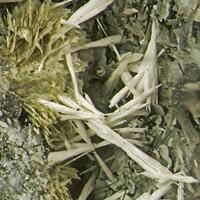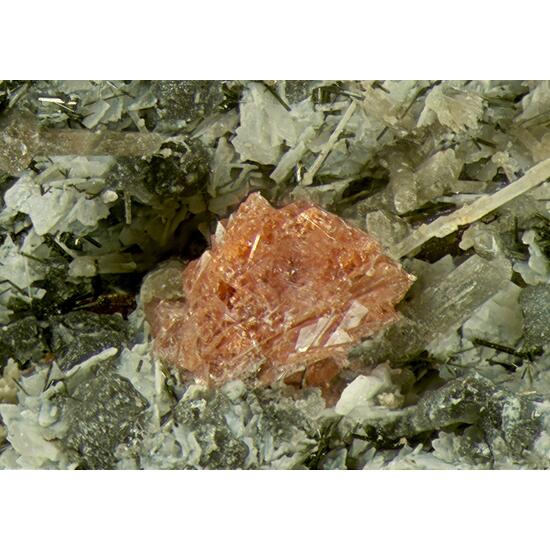Until recently, it was safe to say that the leafy greenish plates shown in the foreground of the first pair of photos (FOV 4.5 x 6.7 mm) were “rinkite”. But now, as at MSH, both rinkite-(Ce) and mosandrite-(Ce) are on the quarry’s species list and I doubt that visual identification is possible. While the formula for rinkite-(Ce) has Na, whereas mosandrite-(Ce), does not, even qualitative EDS might not be sufficient to distinguish the species. That is because Na is not well detected and, moreover, Na can “migrate” under the electron beam, which results in underestimation. Hence “rinkite group” is probably the best that you can do. (Because of the “migration” problem, even expensive WDS might not be definitive.)
In any case, this is a very good example of “rinkite” from the quarry. In addition, there are interesting acicular white calcite crystals, a small aggregate of well-formed thick tabular eudialyte crystals, fairly sharply formed PSM of natrolite after nepheline, and pink/violet/gray prisms that, at MSH, I would call “cancrisilite”. However, neither cancrisilite nor cancrinite is on the current species list, and the best interpretation of the qualitative EDS scan for this material is that it is now natrolite. (See below for details.) Based on the habit, I think that the precursor was more likely cancrisilite than cancrinite, but I have no way to prove it.
The next photo (FOV 4.3 x 6.9 mm) shows more of the pointy calcite crystals (<= 2.3 mm) and a bit more of the “rinkite lettuce”.
The eudialyte aggregate (2.7 mm) is shown in the next pair of photos (FOV 6.0 x 4.3 mm). Also in the photo are a few elongated pink/violet “natrolite after cancrisilite” prisms. Some are quite gemmy – as if unaltered.
Note that the only eudialyte group mineral reported from this quarry is eudialyte itself. It comes in a wide range of colors. While places such as nearby MSH may have larger crystals of eudialyte, they also have other members of the eudialyte group. It is impossible to distinguish among them by color or other visual clues, so verified specimens of "plain" eudialyte are actually quite rare. Specimens from the Saint-Amable sill are a good opportunity to get "real" eudialyte without the expense of WDS, etc.
More of the “cancrisilite” PSMs are shown in the next photo (FOV 7.0 x 4.5 mm). The larger prisms are gray and reach ca 4.6 mm.
The next pair of photos (FOV 6.7 x 4.5 mm) shows some of the rather dark, stubby, natrolite after nepheline PSMs (to 1 mm), along with a bit more “rinkite” and calcite. These are quite different from the “cancrisilite” PSMs, but they are well known from this quarry.
The gray platy crystals in the background of all photos are microcline.
Regarding the “natrolite after cancrisilite” ID: Qualitative EDS scans for natrolite and cancrisilite are virtually indistinguishable – the chemistry is very similar. Nevertheless, the scan (#345 under the “Analysis” tab) for this specimen is more like scans for other natrolite specimens, than for scans for cancrisilite, an example of which (#196) I have also included under the “Analysis” tab. In particular, the Na peak in #196 is a bit higher relative to Si, as is the Al peak – as would be expected. However, comparison of peak heights in qualitative EDS scans for unpolished samples is generally a fool’s errand, so this is merely suggestive – not a proof of anything.
Single item shipping weight (no case) is 4.2 oz (119 g). For shipments outside the USA, up to a total weight < 8 oz (225g), this can be combined with items from this or other auctions for the same postage.
Within the USA, postage for total weights up to 13 oz, ranges from $4.50 to $6.50 (including packing etc) regardless of destination. Above 13 oz, I will use Priority Mail ($7.25 - $9.20 including packing – varies by destination).


































